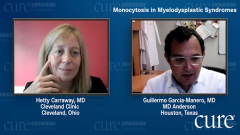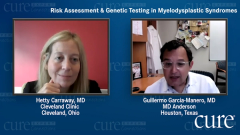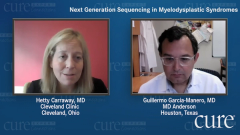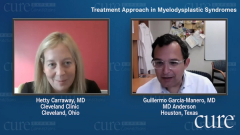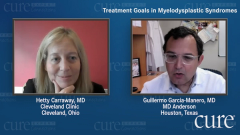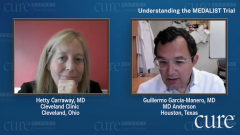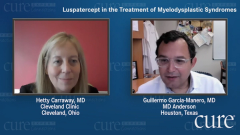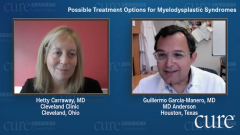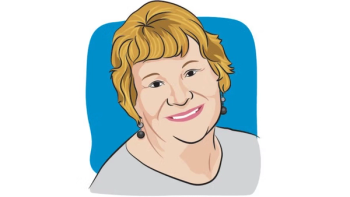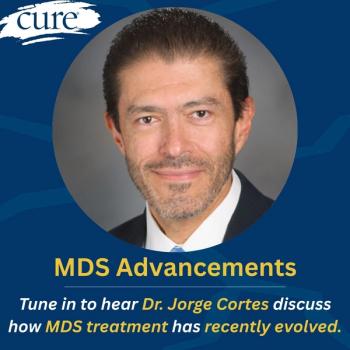
Risk Assessment & Genetic Testing in Myelodysplastic Syndromes
Episodes in this series

Hetty Carraway, MD: We didn’t go through all the details of the cytogenetic testing, and I’m not sure we need to other than to say that there are specific types of chromosomal aberrations that put somebody at higher risk and at lower risk.
Do you describe MDS [myelodysplastic syndrome] in any other way to your patients? Tell me a little more about how you walk them through.
Guillermo Garcia-Manero, MD: What you just said is exactly what I do. Going back to COVID-19, there’s always something a little good that happens after a bad thing, like how we’ve been better about telehealth visits. I don’t know how it is at the Cleveland Clinic, but it takes us a little less than a week to get the chromosome and molecular tests. The morphology we get in one day. Many times, patients who have lower-risk disease go home, and then a week later I set up a telehealth visit. A good part is that we finally have the ability to do this.
Then I joke with the patients. When they are with me in the clinic, I go over a piece of paper about how it’s like a factory, as you said. Then I tell them, “When I call you, you need to ask me back this question. You’re going to examine me.” I’ll say, “These are the three questions. What is the percentage of blasts? What are the chromosomes? What are my mutations? What were the cytopenias?” When I call back, I say, “Do you have the piece of paper with you?” Sometimes they don’t, so you need to look for it. That is key because you have to enable those patients to have that information. They need to understand what the characteristics are and how you’re going to score this disease and make these decisions. I find that extremely important. So I do exactly as you said, and I use the same analogy, but the key is for them to understand what the parameters are because, of course, when we go back through the therapy later, you’re going to look to see if those blasts improve or if the chromosomes change. So the patients and families really need to understand that. In my practice, I follow exactly what you do.
Hetty Carraway, MD: I’m curious to hear a little more. We are doing this next-generation sequencing testing, and you talked about MRD [minimal residual disease]. Tell me how you walk them through the mutation testing and what you say, even at the time of diagnosis, with regard to that information?
Guillermo Garcia-Manero, MD: This is a complex conversation, and maybe you can teach me the right word, because when you talk about genetic testing, people who have children immediately worry about their children and their family. It’s almost universal, that even before we have the genetic testing, the patients will ask, “Is this a family thing? Is this a genetic thing?” I always used to say, “No, this is very rare.” But now we know that there’s some relevance.
The first issue is the terminology. If you start using the word genetics, you have to immediately explain that you’re talking about a mutation on a gene and not something you carry. That can be, particularly with older patients, a little complex to explain germline mutations versus somatic mutations. I tell them that just because these are genes that may be mutated or affected doesn’t mean this runs in your family.
I explain that there are a set of genes that are commonly mutated, that we test for them, and that this just has, in our practice, two different values. One is that although there are no formal molecular classifications of this disease—we know that one hopefully will be coming—at the bottom line, we use this to add information that allows us to prognosticate this disease. For instance, if you have a TP53 gene mutated, the course of this disease will most likely be more aggressive and possibly more difficult to treat. If you have a gene called SF3B1, in the right context, this could be something that could be associated with a slow-growing disease that may not cause problems for many years. I also tell them that we are now using genetic or genomic information to decide on therapy more often. If you have an IDH1 or IDH2 mutation, we may be more inclined to use drugs. Those are rare, but probably 30 or 40 percent of patients benefit from some type of targeted approach based on these pieces of genetic information.
What I see from patients who come to see me is that those genetic tests are being incorporated by most hematologists who do a bone marrow test. The community, once they do the bone marrow, now know what to order: the cytogenetics. I don’t know if you remember, but when you and I started practicing, it would be very common that there would be no chromosome test on the bone marrow, and you would have to repeat the bone marrow just to get that. This improved, and now these genetic tests are added to most of our patients when they come for a second opinion. Sometimes they come faster than the cytogenetic test. So that’s an important discussion. But this issue of what is familial genetic versus not sometimes gets a little complicated to explain.
Transcript Edited for Clarity


